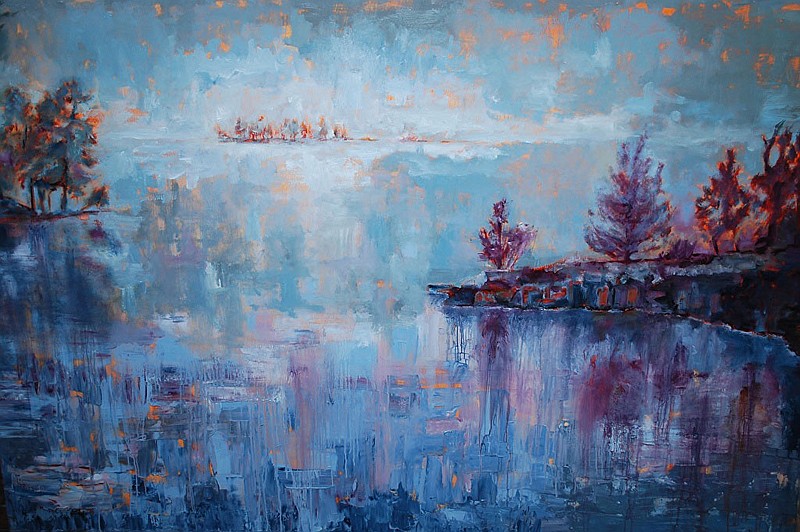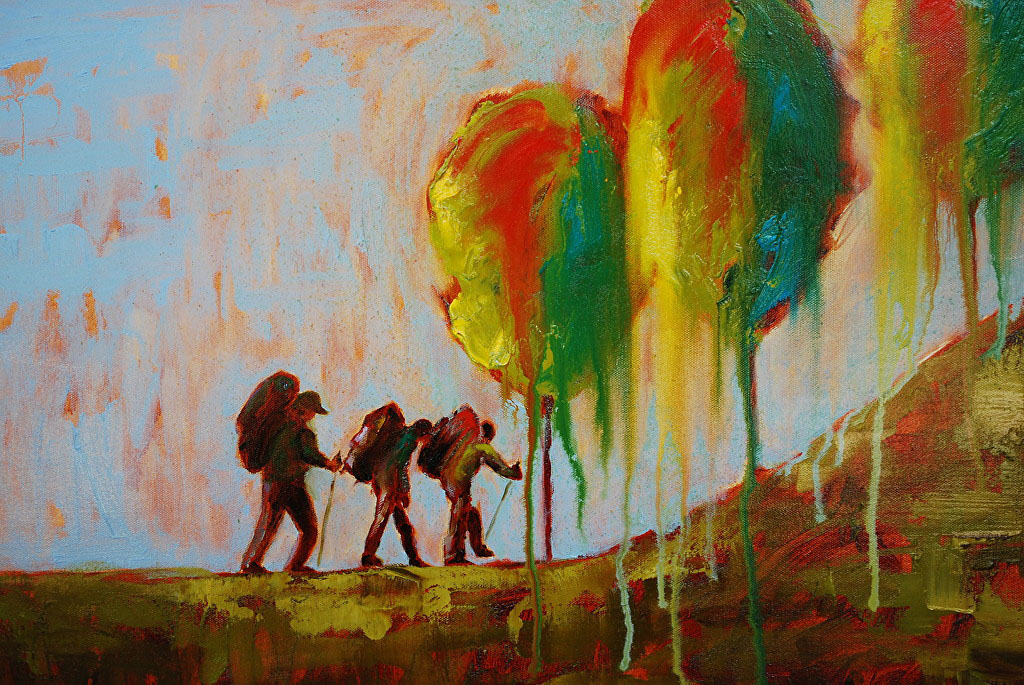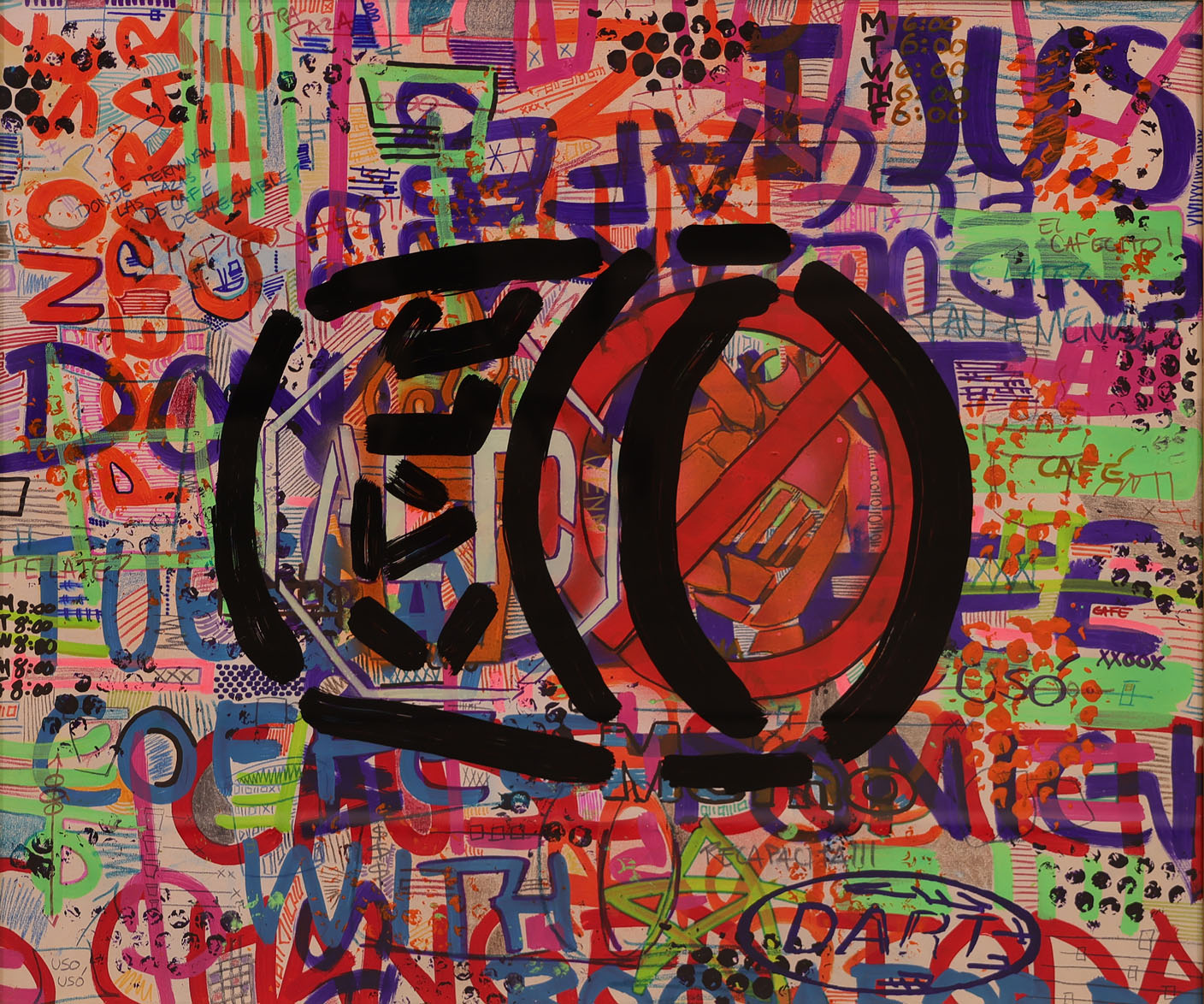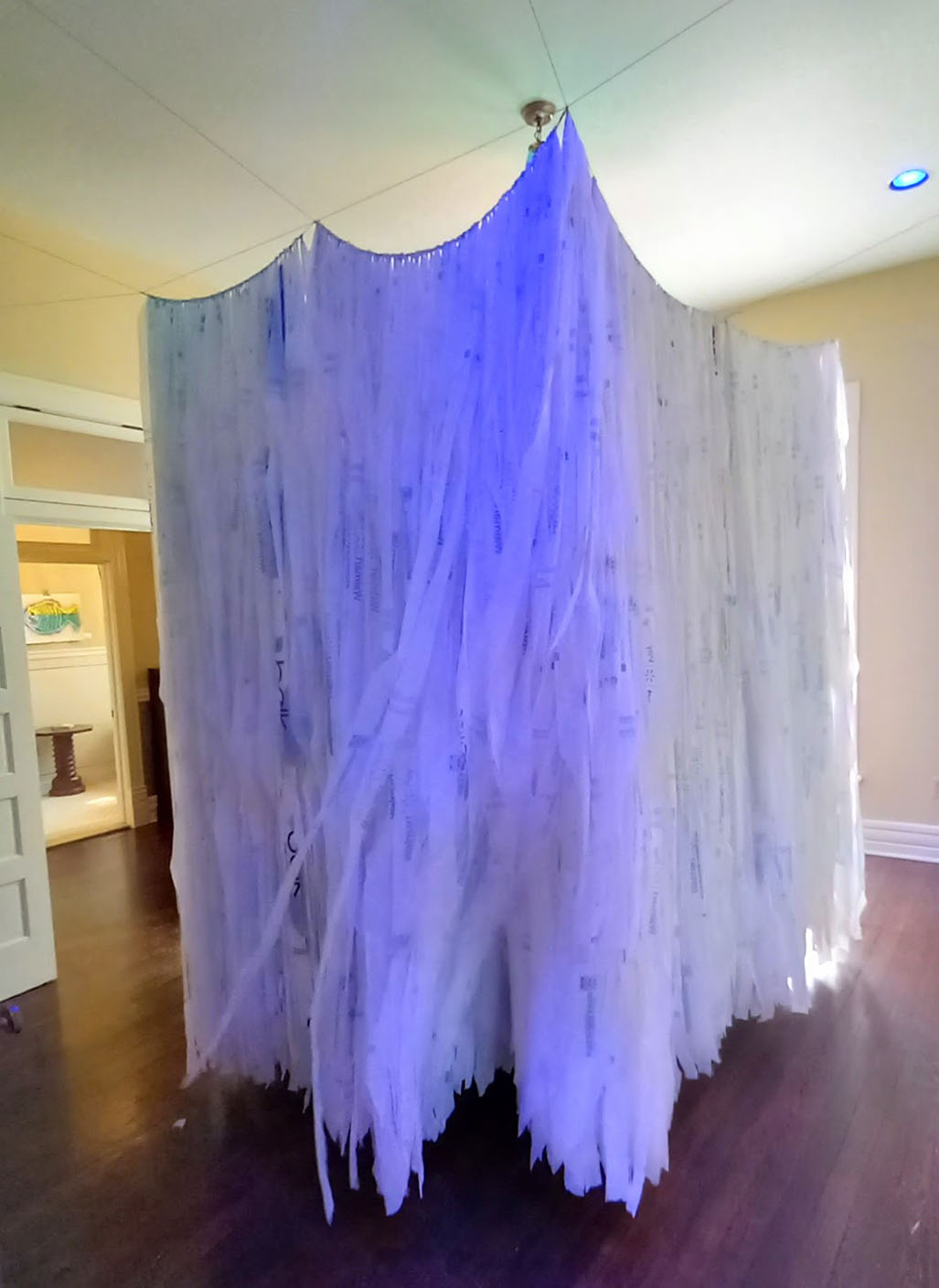When you walk through the door of Art Ventures, the first thing you might hear is a relaxing, oceanic sound. Head to the right, through the converted dining room to the room just beyond, and you'll see strips of plastic bags, suspended from the ceiling to the floor, creating a thick, swaying, cube made up of thousands of pieces of plastic.
At first, the installation is calming and inviting. The plastic sways lackadaisically, swishing in the soft breeze, inviting the viewer to enter. Once inside the installation, the exhibit becomes claustrophobic. Barely any light makes it way through the thousands of strips of plastic engulfing the viewer.
"I try to make the people feel how it could be to 'swim' in the sea that is full of plastics. You can't see anything outside, you need to go through and experiment with what happens inside," says Lourdes Valverde, who created "Under the Sea" with fellow artists David Gómez, Briseida Ochoa and Dexta Rodríguez for the "Goal 14 Water for Life" exhibit on show until Oct. 30 at Art Ventures in Fayetteville.
"The idea for this piece was born from an experience when I lived in Mexico City. I saw a similar installation but with different elements and with a very different purpose, but visually I loved it," says Valverde.
"Goal 14 Water for Life" alludes to the 2030 Agenda for Sustainable Development adopted by the United Nations in 2015, considering specifically the 14th goal, Life Below Water. The exhibit itself "focuses on our necessary symbiotic relationship with water and the way unsustainable production practices and contamination greatly threatens that relationship."
While the artists share a focus for this exhibit, the styles presented differ significantly. "We are artists, and our mission is to communicate what we see and how we feel through our art," Valverde says.
Briseida Ochoa -- a recent Artists 360 Project grant recipient who works in photography, painting, mixed media and printmaking -- incorporates plastic and cyanotype onto her canvases for this show. Her piece, "#plasticpollution #loveplastic" looks like a scan of a plastic bag with the phrase "Thin plastic is everywhere," emblazoned over the image like a warning to the viewer. She also explores the dehumanization of coffee production, touching on how the ongoing crises affects the world at large, through her photos of coffee workers that are printed on coffee filters and presented in glass carafes or on shreds of single-use coffee cups. Her other work in the show includes photography presented in varying formats.
On canvas, David Gomez's "Cafe No Me Late" ("coffee does not beat me" in English) and "Popotitos" focus on what's leftover after that cup of coffee. "Popotitos" has a large straw in the center surrounded by colorful chaos. "Cafe No Me Late" follows a similar theme with a coffee cup shape embedded in the center of bright, neon-hued graffiti and slogans such as "soil erosion" and "pon atenciòn" seen in tire tracks and discarded signs, creating a chaotic immersion one would expect in a landfill. His other paintings in the show seem to have more of a basis in over-industrialization and are examples of his style, which often contains graffiti inspired art, stencils and lots of vibrant color.
Dexta Jean Rodriguez's paintings tend toward a celebration of waterways. She uses a lot of cool and warm colors creating beautiful landscapes with scenes from the Buffalo and Mississippi rivers. On first glance, her painting "No Room in America" seems like a celebration of life with a beautiful baby staring out of a window, but then you notice that the window is lined with barbed wire over an American flag. Another painting focusing on a toast of wine glasses would normally be a celebration, but in the context of the show, there's nothing to celebrate. However, she remains hopeful, writing "my paintings celebrate the rich water resources we have in Arkansas, and somehow I have to believe that we will all become better stewards of our waterways and each other."
For her part, Lourdes' paintings in the exhibit focus heavily on the impact of plastic on the environment, especially in her multi-media creations, "Fake Food," and "Asphyxia," in which she uses those very plastics in the pictures. "Desperation" shows a man who appears to be laughing but is actually suffocating. In her painting, "Asphyxia," rows of mechanical pencils are positioned like arrows toward a choking woman painted onto the canvas.
"My son noticed that there were many mechanical pencils on the floor at the school, so he started to pick them up. In a semester, he got 200 pieces." Lourdes says that she wondered how many of these objects wind up "in the drains, the rivers, and the sea," pointing out that plastics such as these can take 150 years to break down, and even then they become micropieces that "still damage the environment."
That same dread inspired her painting "Fake Food" which depicts a mother bird feeding pieces of trash to her babies in a nest made of plastic bags, showing how the overabundance of trash affects animal life.
"The piece 'Fake Food' is about the problem we have with the birds close to the sea that are taking the plastics from the sea to feed their chicks. Obviously, the chicks die," Lourdes explains. She uses a nest of plastic to reiterate that the birds get stuck in the plastic which prohibits them from flying, eventually leaving the birds to die, too.
Rather than despair, Lourdes hopes that the exhibit inspires people to take a look at their habits and how they affect the world.
"The goal of this exhibition is to make people think a little bit about their habits of consumption and change with simple decisions such as carrying a reusable bag for groceries, having a reusable water bottle, a reusable coffee cup, buying things in a cardboard box or recyclable materials. Simple changes make big changes if all of us do it," Lourdes says.
After the exhibit comes to a close in Fayetteville, it will be at the ACANSA Gallery in North Little Rock from Dec. 16 to Feb. 12, 2023, and then at the River Valley Art Center in Russellville from April 15 to May 13, 2023.
Speaking of recycling, "Under the Sea" will be recycled after the exhibit's run, Lourdes says.
"Or maybe I could construct another piece of art with it. You never know."
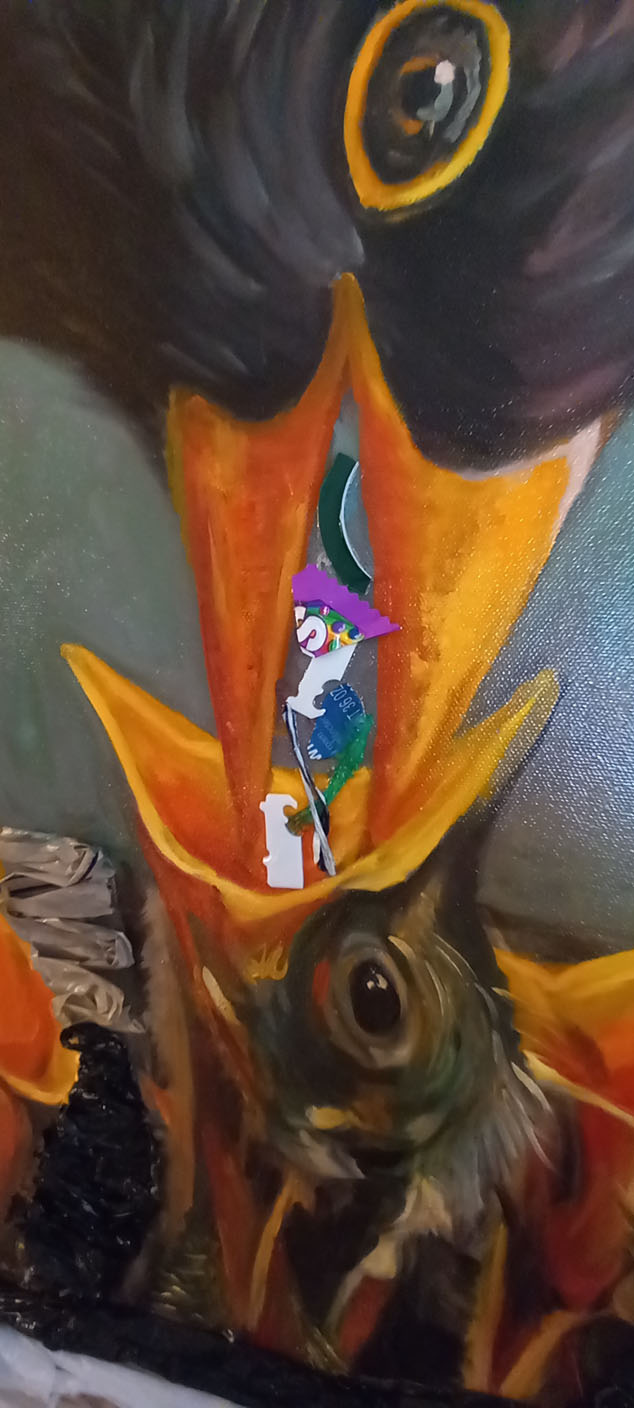 “The piece ‘Fake Food’ is about the problem we have with the birds close to the sea that are taking the plastics from the sea to feed their chicks. Obviously, the chicks die,” explains Lourdes Valverde of her painting. The artist uses plastic waste in the painting to illustrate her point. (NWA Democrat-Gazette/Monica Hooper)
“The piece ‘Fake Food’ is about the problem we have with the birds close to the sea that are taking the plastics from the sea to feed their chicks. Obviously, the chicks die,” explains Lourdes Valverde of her painting. The artist uses plastic waste in the painting to illustrate her point. (NWA Democrat-Gazette/Monica Hooper)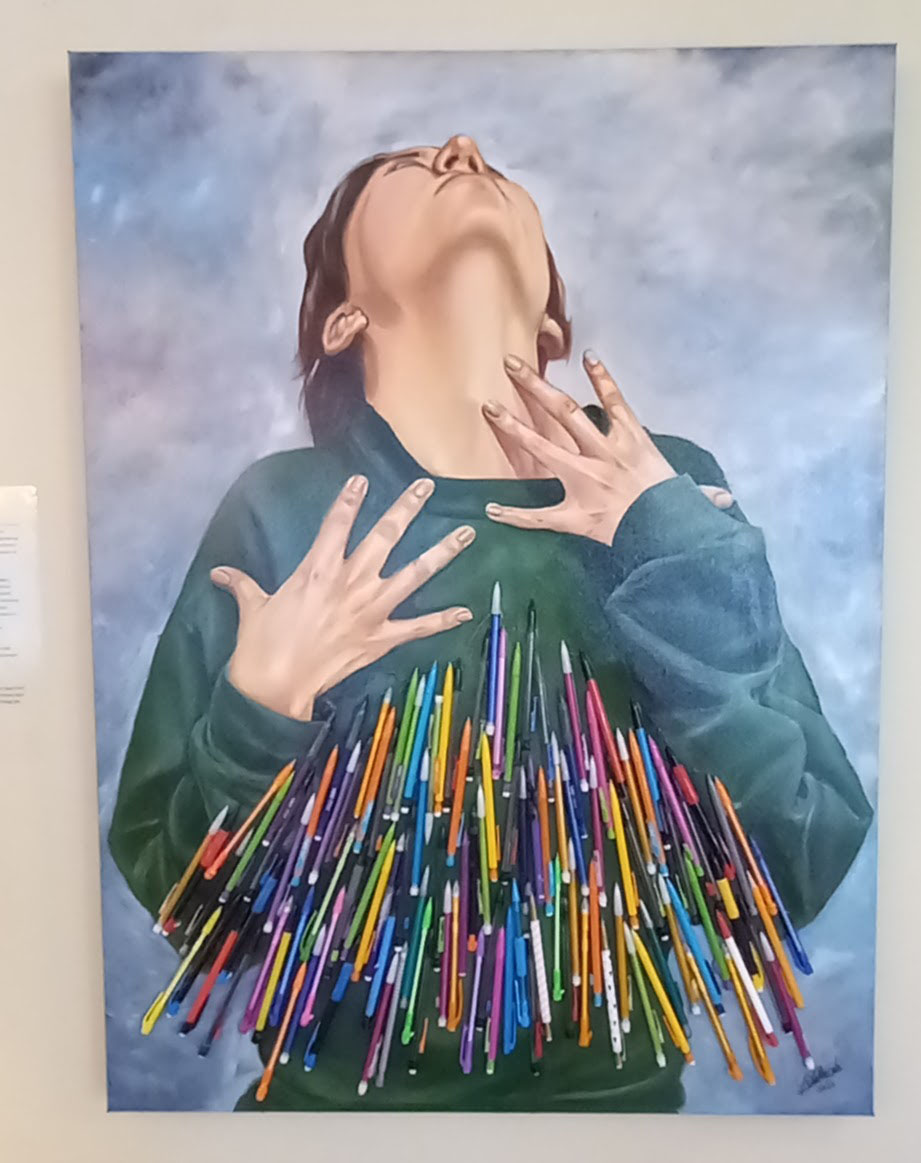 “Asphyxia” is constructed of paint on canvas with mechanical pencils aimed menacingly at a young woman who appears to be choking. Over the course of a school semester, Lourdes Valverde says her son found 200 discarded mechanical pencils. I want to figure out how many of these objects finish in the drains, the rivers, and the sea,” Valverde says, adding that plastics such as these take 150 years” to break down, but even then they become micropieces that “still damage the environment.” (NWA Democrat-Gazette/Monica Hooper)
“Asphyxia” is constructed of paint on canvas with mechanical pencils aimed menacingly at a young woman who appears to be choking. Over the course of a school semester, Lourdes Valverde says her son found 200 discarded mechanical pencils. I want to figure out how many of these objects finish in the drains, the rivers, and the sea,” Valverde says, adding that plastics such as these take 150 years” to break down, but even then they become micropieces that “still damage the environment.” (NWA Democrat-Gazette/Monica Hooper)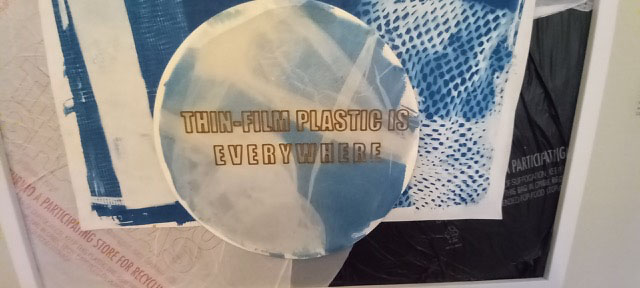 Briseida Ochoa incorporates plastic and cyanotype onto her canvases for this show. Her piece, “#plasticpollution #loveplastic” looks like a scan of a plastic bag with the phrase “Thin plastic is everywhere,” emblazoned over the image like a warning to the viewer. (NWA Democrat-Gazette/Monica Hooper)
Briseida Ochoa incorporates plastic and cyanotype onto her canvases for this show. Her piece, “#plasticpollution #loveplastic” looks like a scan of a plastic bag with the phrase “Thin plastic is everywhere,” emblazoned over the image like a warning to the viewer. (NWA Democrat-Gazette/Monica Hooper)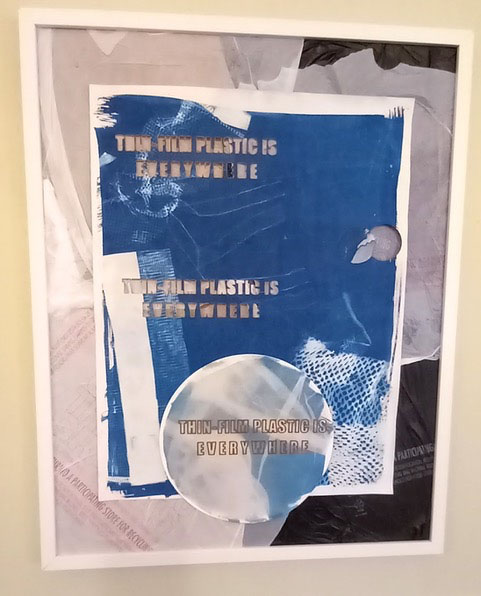 Briseida Ochoa incorporates plastic and cyanotype onto her canvases for this show. Her piece, “#plasticpollution #loveplastic” looks like a scan of a plastic bag with the phrase “Thin plastic is everywhere,” emblazoned over the image like a warning to the viewer. (NWA Democrat-Gazette/Monica Hooper)
Briseida Ochoa incorporates plastic and cyanotype onto her canvases for this show. Her piece, “#plasticpollution #loveplastic” looks like a scan of a plastic bag with the phrase “Thin plastic is everywhere,” emblazoned over the image like a warning to the viewer. (NWA Democrat-Gazette/Monica Hooper)
